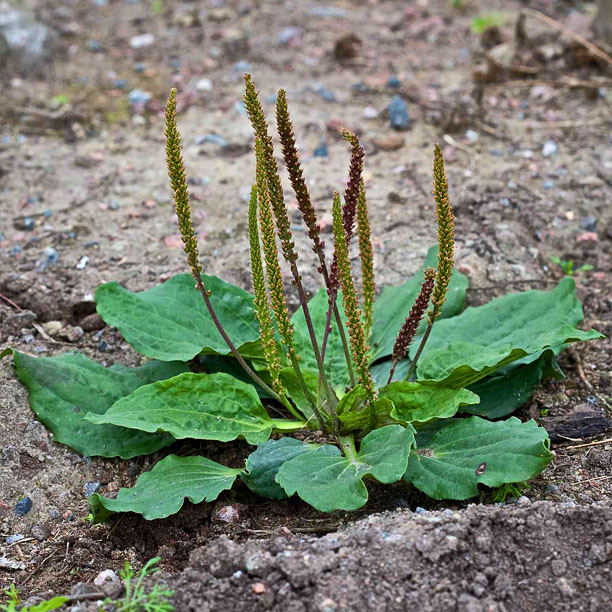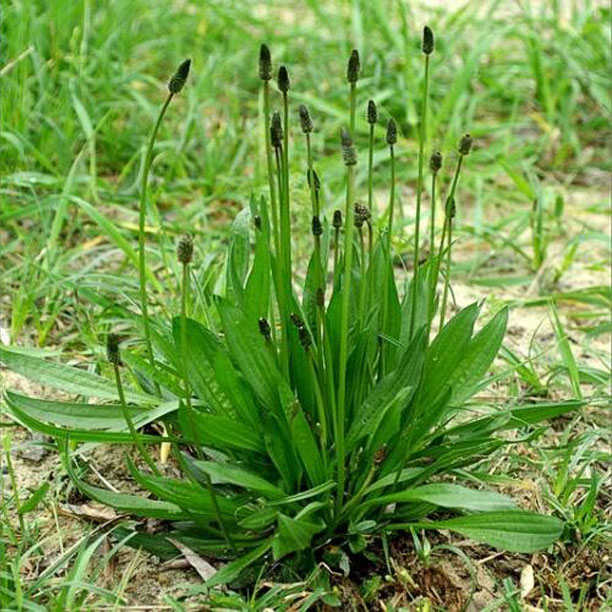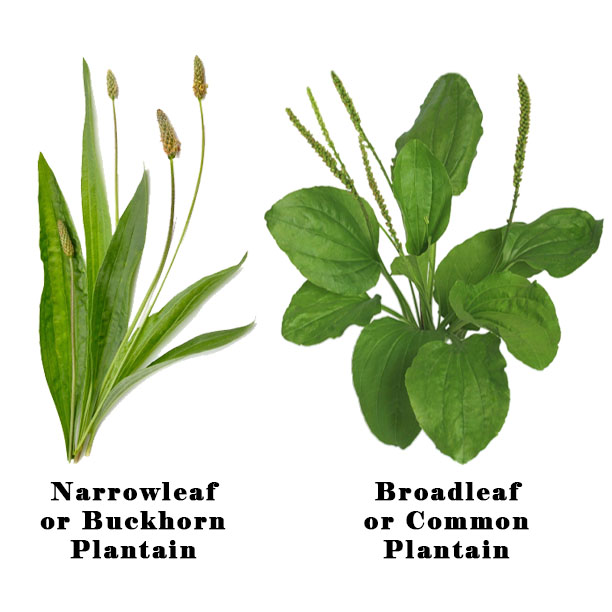Plantain
How To Identify
There are two types of plantain in the US that you are probably going to find. Broadleaf or common plantain and narrowleaf or English / buckhorn plantain. The broadleaf plantain has broad, egg-shaped leaves, whereas narrowleaf plantain has narrow, lance-shaped leaves. Both have prominent veins that all start at the stem and radiate outward over the leaf, ending at the tip. These veins are even more protruding on the underside of the leaf. All of the leaves grow from a central rosette and have smooth edges and a satiny sheen. Flower spikes (seed spikes) form from the center of the leaf rosette and grow seeds almost the whole length of the stem on broadleaf plantain but only at the tip for narrowleaf plantain which look like tiny pinecones on a much longer stem. Both varieties have the foraging telltale identification of when a mature leaf is pulled from the plant at its base, there are usually “strings” protruding from the leaf stem. These are the veins.



Benefits
Plantain contains fatty acids, protein, starches, vitamin B, vitamin C and vitamin K. Its medicinal benefits include being an excellent drawing agent because it’s astringent. It’s also antimicrobial, antioxidant and anti-inflammatory which all make it a useful remedy for coughs, wounds, inflamed skin or dermatitis, insect bites and even slivers.
How To Find
Plantain grows from zone 3 to zone 9 in just about any type of soil. It likes open sunny areas and can often be found in fields along paths and roadways but is very prolific in lawns. It grows from midspring through fall but seed heads can be found from mid-summer into mid-fall. The stems and seed heads on the narrowleaf variety grow up to 2 1/2 feet tall, making it easy to find.
Gathering
Gathering is pretty simple; Collect the tender, new leaves for salads or meals or any healthy-looking leaves for tinctures, salves or as a poultice. Once you have your harvest, wash them gently with water. They can be used fresh or they can be dried for later use. The seeds can be stripped from their stems in the fall.
How To Use
Plantain leaves can be eaten fresh in salad or cooked similar to spinach. They can be used fresh or dried to make a mild tea. To prepare a cup, steep about 2 Tbsp. of crushed leaves by pouring boiling water over them and allowing to infuse for 15 – 20 minutes, then strain and serve or simply stuff a tea ball and steep in your favorite cup or mug. Dried leaves make for a more flavorful drink.
A poultice can be made by grinding the fresh leaves or simply chewing them up and spitting out the crushed leaves (spit poultice) and applying it to the affected area such as a bug bite or burn.
An infusion can be made from the leaves by filling a jar or other container with crushed or ripped leaves and then filling the jar with olive oil and allowing it to steeping for at least two weeks. At the end of the two weeks, strain the oil into a new container. This infusion can be used as is topically to treat skin irritations or made into a salve. Watch our video for more information about infusions and salves.
The dried seeds can be ground into a flour extender replacing up to 25% of the flour called for in baking recipes. They can also be used as they are commercially, for the production of mucilage. The seeds are a psyllium which is mainly used as a dietary fiber to relieve symptoms of both constipation and mild diarrhea, and occasionally as a food thickener. For example, I believe Metamucil is made from the psyllium of plantain.
Preservation
To preserve plantain leaves, place them into paper bags, or on a screen (window screen or similar) and allow them to dry in a dry dark place with good airflow. They can also be dehydrated using very low or no heat in a standard dehydrator or freeze dried. Oven drying isn’t recommended as the heat can damage the medicinal benefits. They can also be made into an infusion or salve for long term storage.
The seeds can be dried in a similar method as the leaves and either stored as they are or ground into a flour.